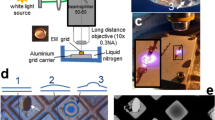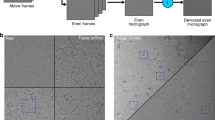Abstract
Recent advances in cryo-electron microscopy (cryo-EM) have enabled protein structure determination at atomic resolutions. Cryo-EM specimens are prepared by rapidly freezing a protein solution on a metal grid coated with a holey carbon film; this results in the formation of an ice film on each hole. The thickness of the ice film is a critical factor for high-resolution structure determination; ice that is too thick degrades the contrast of the protein image while ice that is too thin excludes the protein from the hole or denatures the protein. Therefore, trained researchers need to manually select “good” regions with appropriate ice thicknesses for imaging. To reduce the time spent on such tasks, we developed a deep learning program consisting of a “detector” and a “classifier” to identify good regions from low-magnification EM images. In our method, the holes in a low-magnification EM image are detected via a detector, and the ice image on each hole is classified as either good or bad via a classifier. The detector detected more than 95% of the holes regardless of the type of samples. The classifier was trained for different types of samples because the appropriate ice thickness varies between sample types. The accuracies of the classifiers were 93.8% for a soluble protein sample (β-galactosidase) and 95.3% for a membrane protein sample (bovine heart cytochrome c oxidase). In addition, we found that a training data set containing ~ 2100 hole images from 300 low-magnification EM images was sufficient to obtain good accuracy, such as higher than 90%. We expect that the throughput of the cryo-EM data collection step will be greatly improved by using our method.



Similar content being viewed by others
References
Cheng Y (2015) Single-particle Cryo-EM at crystallographic resolution. Cell 161:450–457. https://doi.org/10.1016/j.cell.2015.03.049
Chollet F (2017) Xception: deep learning with Depthwise separable convolutions. arXiv:1610.02357v3. https://arxiv.org/abs/1610.02357v3
Dubochet J, Chang J-J, Freeman R, Lepault J, McDowall AW (1982) Frozen aqueous suspensions. Ultramicroscopy 10:55–61. https://doi.org/10.1016/0304-3991(82)90187-5
Fernandez-Leiro R, Scheres SH (2016) Unravelling biological macromolecules with cryo-electron microscopy. Nature 537:339–346. https://doi.org/10.1038/nature19948
Lei J, Frank J (2005) Automated acquisition of cryo-electron micrographs for single particle reconstruction on an FEI Tecnai electron microscope. J Struct Biol 150:69–80. https://doi.org/10.1016/j.jsb.2005.01.002
Noble AJ, Wei H, Dandey VP, Zhang Z, Tan YZ, Potter CS, Carragher B (2018) Reducing effects of particle adsorption to the air-water interface in cryo-EM. Nat Methods 15:793–795. https://doi.org/10.1038/s41592-018-0139-3
Redmon J, Farhadi A (2018) YOLOv3: an Incremental Improvement. arXiv:1804.02767. https://arxiv.org/abs/1804.02767
Suloway C, Pulokas J, Fellmann D, Cheng A, Guerra F, Quispe J, Stagg S, Potter CS, Carragher B (2005) Automated molecular microscopy: the new Leginon system. J Struct Biol 151:41–60. https://doi.org/10.1016/j.jsb.2005.03.010
Tan YZ, Cheng A, Potter CS, Carragher B (2016) Automated data collection in single particle electron microscopy. Microscopy 65:43–56. https://doi.org/10.1093/jmicro/dfv369
Tsukihara T, Aoyama H, Yamashita E, Tomizaki T, Yamaguchi H, Shinzawa Itoh K, Nakashima R, Yaono R, Yoshikawa S (1995) Structures of metal sites of oxidized bovine heart cytochrome c oxidase at 2.8 A. Science 269:1069–1074. https://doi.org/10.1126/science.7652554
Unwin N (2013) Nicotinic acetylcholine receptor and the structural basis of neuromuscular transmission: insights from Torpedo postsynaptic membranes. Q Rev Biophys 46:283–322. https://doi.org/10.1017/S0033583513000061
Acknowledgments
We thank Mr. Itto Higuchi for his assistance in the early stage of this work. We also thank Dr. Takeshi Kaneko, Mr. Isamu Ishikawa, and Mr. Yoshihiro Ohkura for setting up of the cryo-electron microscope.
Funding
This research was partially supported by the Platform Project for Supporting Drug Discovery and Life Science Research (Basis for Supporting Innovative Drug Discovery and Life Science Research (BINDS)) from AMED under Grant Number JP19am0101107. This work was also supported by JSPS KAKENHI Grant Number 15H05775 and by AMED under Grant Number JP19ae0101046.
Author information
Authors and Affiliations
Corresponding author
Ethics declarations
Conflict of interest
The authors declare that they have no conflict of interest.
Additional information
Publisher’s note
Springer Nature remains neutral with regard to jurisdictional claims in published maps and institutional affiliations.
Rights and permissions
About this article
Cite this article
Yokoyama, Y., Terada, T., Shimizu, K. et al. Development of a deep learning-based method to identify “good” regions of a cryo-electron microscopy grid. Biophys Rev 12, 349–354 (2020). https://doi.org/10.1007/s12551-020-00669-6
Received:
Accepted:
Published:
Issue Date:
DOI: https://doi.org/10.1007/s12551-020-00669-6




